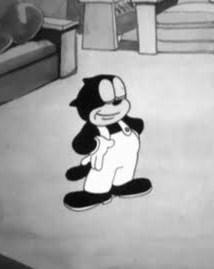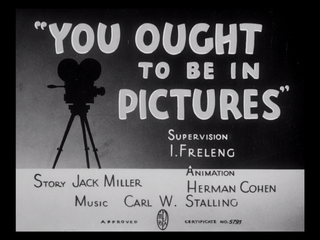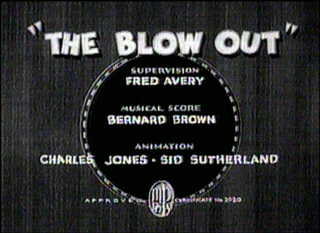Plot
Porky Pig lights candles on a birthday cake while singing and stuttering, 'Happy Birthday' to himself. Someone rings the doorbell. Porky looks to the left while his dog, Black Fury, steals a bit of cake. Porky opens the door, and the mailman knocks on Porky's head twice. He tells Porky he received a package from his uncle, Pinkus. Inside the package is a tiny silkworm. The silkworm knits garments whenever the word sew is spoken, so Porky commands the worm to sew and it sews a sock as Porky and Black Fury look on in awe. Porky gives the command again. The worm sews a brassiere, which Porky disposes of bashfully as he puts the worm in his coat.
Porky and Black Fury enter the bathroom, where Porky applies hair-growth formula on his own head, though with no result. Then, needing to get ready, Porky hurriedly leaves the bathroom. Black Fury takes the formula and squirts 16 drops on his head. He realizes that it contains 99% alcohol, and he begins to drink it. He then starts to have the hiccups, and becomes intoxicated, loudly shouting "Happy Birthday!"
Meanwhile, Porky hears the doorbell again. It is his friend Penguin, who rushes in, gives Porky a larger present, and begins wolfing down ice cream. He slices the cake, leaving the slice and taking the remaining cake. Goosey (with a pre-Daffy smile) saunters in and holds out his hand for Porky to shake. The hand is a prop, adorned with a sign reading "Happy Birthday, Fat Boy!". Porky angrily throws the sign and looks at Goosey as he turns to the right, and he chuckles at him, stating "He's so silly." Porky repeatedly stutters the word so, causing the silkworm in Porky's pocket to mistake the word for "sew" and begins sewing garment after garment. As garments come from underneath Porky's jacket, he notices they are women's underwear and brassieres; he hides them guiltily. He then tosses the silkworm away from him. The silkworm lands in Penguin's ice cream, continuing to sew garments, which end up in the ice cream. Disgusted, Penguin pulls a sock out of the ice cream after he caught it with his spoon. He continues eating until after disgusted came from his mouth. He pulls him out of his mouth and as he has difficulty swallowing, a top hat forms in his mouth. He throws it and eats another load of ice cream, but he accidentally ate another top hat. The hat pops up, and Penguin's head assumes the shape of it. Failing to quell the hat, Penguin shouts for Goosey's help, who rams Penguin's head into the wall twice. After Penguin thanks Goosey, he hits him with a mallet and slams a washtub over his head, to no avail by forming a hole.
Black Fury, looking shaggy after ingesting the hair-growth formula, attempts to do the opposite. After putting on the cream, he starts the electric razor. The razor takes on the qualities of a snake, and attacks Black Fury as he runs to the hallway. Porky mistakes Black Fury for a mad dog while Porky finishes the last pieces of the ice cream, and the party guests including Porky (acting like a train while holding Goosey) rushed around the house with Black Fury, not realizing that the "rabid dog" is actually Porky's pet. Penguin then acts like he is acting like the clothes hanger while Porky and Goosey rushed along, as Penguin puts the real stool back.
After several more antics, including the three managing suitcases, Porky and Goosey rush inside the closet, and slam the door, leaving Penguin alone. Porky and Goosey look to the right while holding a match, knowing it is Black Fury. The two scream when Penguin knocks on the door and says that he wants to come in. Porky and Goosey run over Penguin in the flash and managed the suitcases and Penguin starts to throw a fit, and Black Fury runs over Penguin and he stops arguing. Both Black Fury and Penguin rush to Porky's bed and hide under his blanket. Penguin then screams when he sees Black Fury, who still has shaving cream on. The bed then opens up, with Porky and Goosey hiding under. Porky and Goosey both rush out of the room, and Penguin (attached by a bedroom spring) starts springing forwards and backwards, and is attacked by Black Fury. The shaving cream dissolves during the fight, and Porky sees that it is just Black Fury. Penguin angrily rolls up his "sleeve" and stares Black Fury down, uttering "So..." in anticipation of a fight. This sets off the silkworm, who wraps Penguin up into a state of mummification and once again has a top hat pop up as his head. Goosey hits Penguin in the head with a mallet from earlier, dazing him, as the cartoon ends. [4]













